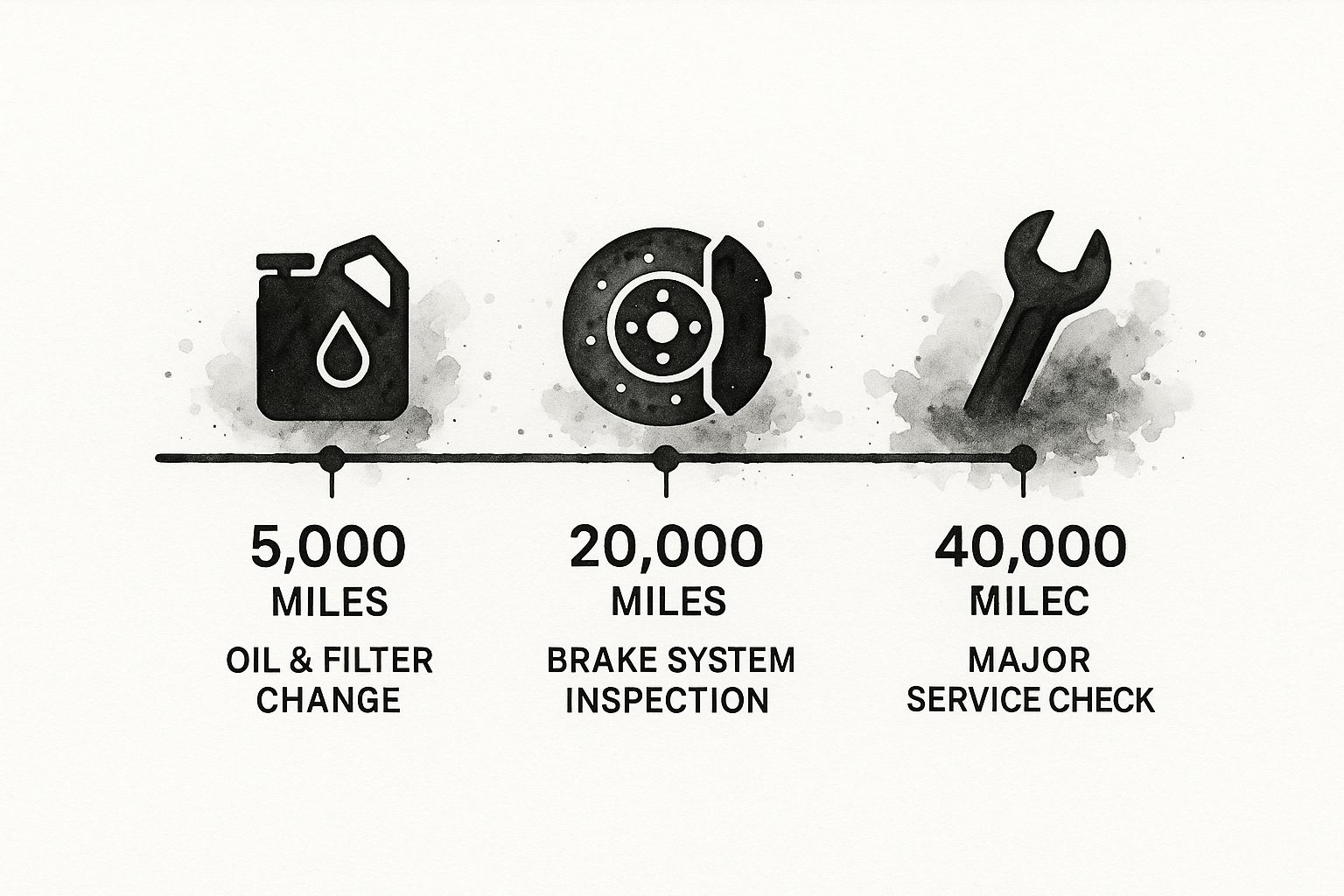
Kwik Kar Service Coupon
Get upto $20 OFF on all services.
Regular car servicing is more than just a good idea; it's crucial for your vehicle's health, performance, and lifespan. Just like regular doctor check-ups, preventative car maintenance catches potential problems early, stopping small issues from becoming major, expensive repairs. This proactive approach keeps your car running smoothly for longer and ensures it performs at its best.
A well-maintained engine, for example, runs more efficiently, giving you better gas mileage and lower emissions. Regular servicing also helps maintain your car's resale value, making it a wise financial decision. This makes regular maintenance essential for maximizing both the life and value of your car.
Regular car servicing offers several important advantages. Consistent maintenance keeps your warranty valid by meeting manufacturer requirements. It also improves safety by ensuring critical parts like brakes and tires are in top condition. What's more, regular servicing can boost your fuel efficiency.
Some drivers see improvements of 15-20% just by following the manufacturer's recommended service schedule. You can learn more about oil changes and tire rotations here. These improvements not only save money on gas but also help the environment. This highlights the automotive industry’s recognition of regular maintenance.
Regular car servicing is essential for performance and longevity. The global vehicle periodic maintenance market is growing, driven by increasing awareness of this fact. The market, valued at USD 936.33 billion in 2024, is expected to reach USD 1,374.05 billion by 2034, a CAGR of 3.91%. This growth shows the global recognition of preventative maintenance's value.
In large markets like Asia-Pacific, the 2023 leader in market share, increased awareness of regular maintenance fuels market growth. Find more detailed statistics here. This trend underscores the importance of proactive car maintenance. You might also be interested in: Our sitemap. Understanding why regular servicing is necessary helps determine how often your car needs professional attention, which we'll cover next.

Staying on top of your car's maintenance needs often means sticking to a schedule. A great resource for understanding this is this helpful article on car maintenance schedule by mileage. Think of your manufacturer's service schedule, located in your owner's manual, as your car's personalized maintenance guide. It outlines the specific services needed to keep everything running smoothly and safely.
This schedule isn't random; it's carefully designed to help your car last longer and prevent expensive repairs in the future. It takes into account both time and mileage.
Manufacturer schedules use both time and mileage intervals. This means some services are due after a certain amount of time, even if you haven't driven much. For example, fluids like brake fluid can break down over time, even if your car sits idle.
Other services are triggered by the miles you put on your car. Certain components wear out with use, like your tires or air filter. Oil changes, tire rotations, and air filter replacements fall into this category. Sometimes, the calendar is more important than the odometer, especially for cars that aren't driven often.
Service schedules generally differentiate between minor and major services. Minor services, often recommended every 5,000-7,500 miles, usually include things like oil changes, filter replacements, and quick inspections. These check-ups are important for catching small problems before they become big ones.
Major services, typically recommended every 30,000 miles, are much more thorough. They involve more detailed inspections and often include replacing key parts like spark plugs, timing belts, and transmission fluid. Ignoring these major services can lead to serious and expensive repairs later.
To help illustrate the typical differences in service intervals, let's take a look at the following table:
| Service Type | Economy Cars | Luxury Vehicles | SUVs/Trucks | Key Components Checked |
|---|---|---|---|---|
| Oil Change | 5,000 miles | 7,500 miles | 7,500 miles | Engine oil, oil filter |
| Tire Rotation | 7,500 miles | 7,500 miles | 7,500 miles | Tire condition, tread depth, wear pattern |
| Air Filter | 15,000 miles | 15,000 miles | 15,000 miles | Air filter restriction, cleanliness |
| Brake Fluid Change | 30,000 miles | 30,000 miles | 30,000 miles | Brake fluid level, condition, potential leaks |
| Spark Plugs | 30,000 miles | 60,000 miles | 60,000 miles | Spark plug condition, electrode wear |
| Timing Belt | 60,000-100,000 miles | 60,000-100,000 miles | 60,000-100,000 miles | Timing belt condition, tension, wear |
As you can see, there are some differences in service intervals across different vehicle types. It's important to refer to your owner's manual for the specific recommendations for your car.
While owner's manuals can be dense, understanding the main service intervals is crucial. Most manuals present services in a table, showing the recommended mileage or time interval for each task. Pay close attention to the recommendations for your specific car’s make and model, as these can differ.
Some manufacturers provide different schedules for "normal" driving versus "severe" driving, like lots of stop-and-go traffic or extreme temperatures. Choosing the right schedule based on your driving habits helps ensure your car gets the care it needs. Knowing how important these services are helps car owners prioritize essential maintenance and make informed decisions about their car's care. This proactive approach not only saves you money but also helps ensure your car is safe and reliable for years to come.

While manufacturer service schedules offer a helpful baseline for car maintenance, they don't capture the full picture. Your car's service needs are as unique as your fingerprint, shaped by various factors beyond simple mileage. Understanding these factors is essential for maximizing your car's lifespan and ensuring it runs smoothly.
Think about your daily commute. A short, 10-mile drive in stop-and-go traffic puts considerably more stress on your vehicle than a 50-mile highway trip. Urban driving can wear down components up to three times faster than highway driving because of the constant braking, accelerating, and idling. This means your car might require more frequent service even with lower mileage if you mostly drive in the city. Driving off-road or towing heavy loads also adds stress, requiring more frequent inspections and maintenance.
Changing seasons also have a big impact. Extreme heat and cold require specific maintenance often not addressed in standard schedules. Intense summer heat can strain your car’s cooling system, making regular checks and fluid top-offs crucial. Winter’s freezing temperatures require special attention to your battery, fluids, and tires. Ignoring seasonal changes can significantly shorten the lifespan of essential components.
Your vehicle's age significantly affects its maintenance needs. As cars age, parts wear down and require more frequent attention. The 7-10 year mark often represents a turning point when many vehicles need more frequent service. This is due to the average lifespan of components like timing belts and water pumps. Neglecting these age-related service needs can lead to breakdowns and expensive repairs. Many car owners fall behind on routine maintenance. For instance, 29% of Americans are overdue for oil changes, and 44% haven't rotated their tires as needed. The global automotive repair and maintenance market grew from $960.98 billion in 2024 to $1051.52 billion in 2025, partly due to this and the increasing number of vehicles on the road. You can find more detailed statistics here. This is especially important as the average age of a vehicle is currently about 12.3 years and rising.
The type of vehicle you own also dictates how often it needs service. Electric, hybrid, and high-performance vehicles have unique maintenance requirements. Electric cars require fewer oil changes but more frequent battery checks. Hybrids need specialized service for their dual power systems. High-performance vehicles, with their powerful engines, demand more frequent and specialized maintenance. Understanding these specific needs allows you to create a tailored maintenance plan, ensuring your car's longevity, reliability, and peak performance.
Knowing how often to service your car can be confusing. This section offers clear maintenance advice, based on expert recommendations and research, to give you a reliable maintenance schedule.
Synthetic oils have changed oil change intervals. They've extended the traditional 3,000-mile interval to 7,500-10,000 miles for many vehicles. Synthetic oil resists degradation and maintains its lubricating qualities longer. However, tough driving conditions like stop-and-go traffic, temperature extremes, and towing require more frequent changes. Check your owner’s manual and consider changing your oil more often if your driving is demanding.
Filters play a vital role in your car's health. Replacing them on schedule is essential. Change your oil filter with every oil change. The air filter, which prevents dirt from entering the engine, typically needs replacing every 15,000-30,000 miles. The cabin air filter, cleaning the air inside your car, should be replaced every 12,000-15,000 miles or yearly. Delaying these replacements can decrease fuel efficiency and potentially damage your engine.
Brake maintenance is more than just changing pads. Regular inspections every 20,000 miles ensure everything works correctly. Watch for squealing, grinding, or a soft brake pedal – these are signs of problems needing immediate attention. Brake fluid should be replaced every 2-5 years because it absorbs moisture, reducing its effectiveness.
The timing belt synchronizes crucial engine components. Replacing it between 60,000 and 100,000 miles (as recommended by your owner's manual) is crucial. Ignoring this can cause major engine damage, leading to repairs costing $4,000 or more. This preventative maintenance is essential.
Some manufacturers suggest long intervals between transmission fluid changes. However, many mechanics recommend service every 30,000-60,000 miles for optimal performance. Regular transmission service can prevent expensive repairs and prolong your transmission’s life, especially for towing or stop-and-go driving.

The infographic visualizes key mileage-based service intervals. This includes oil and filter changes around every 5,000 miles, brake inspections at 20,000 miles, and major checks at 40,000 miles. These regular checks prevent larger problems and keep your car running well. While these are helpful guidelines, remember that your car’s needs may differ. Always consult your owner’s manual.
The following table provides a more detailed look at essential car maintenance tasks:
Essential Car Maintenance Timeline: A detailed schedule of when to perform critical maintenance tasks based on time and mileage.
| Maintenance Task | Mileage Interval | Time Interval | Warning Signs | DIY Difficulty |
|---|---|---|---|---|
| Oil Change | 7,500-10,000 miles | Every 6 months – 1 year | Dark, dirty oil; low oil level | Easy |
| Oil Filter Change | 7,500-10,000 miles | Every 6 months – 1 year | Easy | |
| Air Filter Change | 15,000-30,000 miles | Every 1-2 years | Reduced engine performance, decreased fuel efficiency | Easy |
| Cabin Air Filter Change | 12,000-15,000 miles | Every year | Reduced airflow from vents, unpleasant odors | Easy |
| Brake Inspection | 20,000 miles | Every year | Squealing, grinding, soft brake pedal | Medium |
| Brake Fluid Change | Every 2-5 years | Soft brake pedal, decreased braking performance | Medium | |
| Timing Belt Replacement | 60,000-100,000 miles | Every 5-7 years | Hard | |
| Transmission Fluid Change | 30,000-60,000 miles | Every 2-3 years | Difficulty shifting, transmission slippage | Hard |
This table highlights the importance of regular maintenance. By adhering to a schedule based on mileage and time, and noting your car's specific needs, you can extend its life and avoid costly future repairs.

Where you live has a big impact on how often your car needs servicing. Different climates and driving conditions stress your vehicle in different ways. This means tailoring your maintenance schedule to your location is essential for optimal car health. For a broader view of available services, check out our sitemap.
In areas with harsh winters, proper winterization is crucial. When temperatures plummet below freezing, certain fluids need more frequent checks. Antifreeze levels, for instance, should be monitored and topped off regularly. Extreme cold also affects battery performance, meaning more frequent testing and possibly even replacement. Don't underestimate the importance of winter-specific maintenance, as frozen fluids can cause serious damage.
If you live in a hot climate, cooling system maintenance is paramount. High temperatures strain your engine's cooling system, so regular checks are vital. Watch for signs your car is struggling with the heat, like overheating, leaks, or unusual engine noises. Addressing these promptly can prevent costly repairs and breakdowns.
Fuel quality varies from region to region, affecting engine performance and maintenance needs. Lower quality fuel can lead to build-up, requiring more frequent fuel system cleaning. Pay attention to the fuel you use and consider fuel additives to optimize engine performance. Address any performance issues quickly to avoid long-term problems.
High pollution levels in urban areas also impact your car's maintenance. Pollution can clog filters and sensors faster, necessitating frequent replacements. Your cabin air filter, for example, might need more frequent changes to maintain clean air inside. Engine air filters and other sensors may also require more attention due to increased pollutant exposure.
Different regions have specific regulatory inspection requirements, often including emissions and safety checks. Staying on top of these and incorporating them into your maintenance schedule is essential for compliance and roadworthiness. The global automotive repair and maintenance market is segmented by region, with Western Europe leading in 2024, followed by Asia-Pacific. Factors like the rise of electric and connected vehicles, requiring different maintenance approaches, influence market growth. In Asia-Pacific, increased awareness of regular maintenance drives expansion, making it the largest market for vehicle periodic maintenance in 2023. The projected global market growth to USD 1.6 trillion by 2031 underscores the importance of regular car servicing. Learn more about the global automotive market here. Integrating location-specific needs into your car maintenance routine is crucial for optimal performance and longevity.
Maintaining your car with a regular service schedule is important. However, sometimes your car needs immediate attention. Ignoring these urgent signs can lead to expensive repairs or even dangerous driving situations. Knowing how to recognize these signals is just as important as routine maintenance.
Your dashboard is how your car communicates with you. It’s crucial to understand what the different warning lights mean. Amber lights usually mean you need to address something soon, but it’s not an immediate emergency. For instance, a low tire pressure light (often amber) tells you to add air when you can. Red warning lights, however, signal a serious problem that needs immediate action. A red temperature warning light, for example, means you need to pull over right away and turn off your engine to prevent damage.
Your car also communicates through sounds. A quiet ticking sound might not be a problem. But a loud knocking sound could mean serious engine trouble. It's helpful to learn the difference between normal car sounds and unusual noises. Changes in sound, like a suddenly louder exhaust, can also indicate a problem. If you hear something unusual, have a professional check it out. You might find helpful information at KKRichardson's News.
Small changes in how your car performs can be early signs of bigger problems. Steering resistance, making your car harder to turn, could point to power steering problems. Transmission hesitation, when your car hesitates while shifting gears, could signal a transmission issue. These small problems can become major if ignored.
Regular visual checks can help you find problems before they get worse. Knowing what fluid leaks look like can help you identify potential issues. For instance, a greenish puddle might be a coolant leak, while a reddish-brown puddle might mean a brake fluid leak. Also, regularly check your tires for uneven wear and tear or any damage.
Catching these urgent signs early can save you money and hassle. Taking quick action when you notice something unusual will help your car last longer and keep you safe.
Visit Kwik Kar Oil Change and Auto Care in Richardson, TX today! Our ASE-certified technicians can diagnose and repair your car to keep it running well. Schedule your appointment now!
CLICK LINK BELOW TO LEARN MORE ABOUT OUR SERVICES

Get upto $20 OFF on all services.